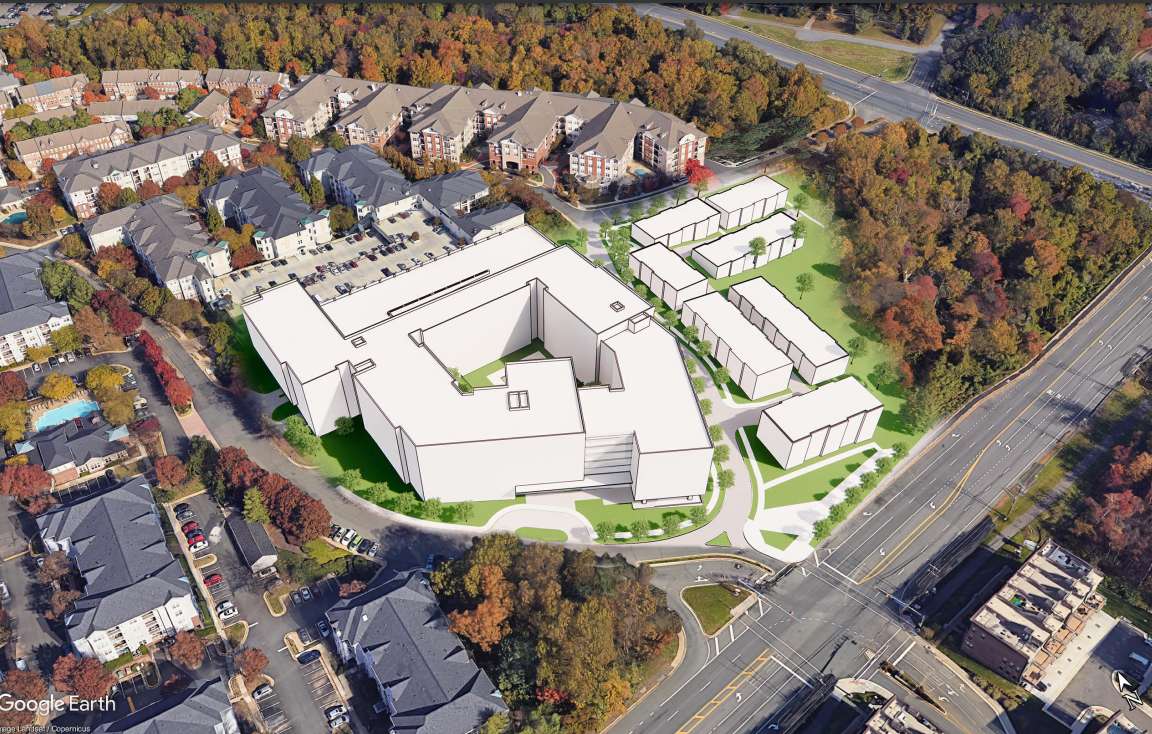
A redevelopment plan for the former ICF headquarters in Oakton has officially been submitted to Fairfax County.
Filed in late December, the application from IBW HB LLC — an apparent affiliate of Arlington-based developer Insight Property Group — envisions replacing the 1980s-era Hunters Branch office complex at 9300 and 9302 Route 29 with a 8-story apartment building and townhomes.
With a comprehensive plan amendment to allow the redevelopment already in the works, the developer says a change is needed for the property “to contribute positively to the community and to better serve the local economy” after its longtime tenant, the consulting firm ICF, moved to Reston.
“IBW HB LLC is excited for the opportunity to put forward a thoughtful and high quality redevelopment that will replace obsolete and predominantly vacant office uses with modern residential uses within close proximity to transit,” a statement of justification for the application says.
Developer requests to turn commercial properties into residential ones have become common, as offices struggle to rebound from the pandemic, which fueled an embrace of telework. A similar redevelopment has been proposed for AT&T’s Oakton campus, and nearby, the Pan Am Shopping Center is poised to add housing in an effort to rejuvenate the strip mall.
“Extending this pattern to the Hunters Branch Property is logical and creates inherent compatibility and additional opportunities to deliver meaningful connections and open spaces that will benefit the new and existing residences of the Vienna [Transit Station Area] alike,” McGuireWoods land use agent Scott Adams wrote in the statement.
Pitched as a “gateway development” for the Vienna Metro station area, the proposed apartment building at Hunters Branch would have up to 485 dwelling units across 485,000 square feet of space. It would be located on the western side of the 13.9-acre property along Hunters Glen Way, replacing an existing, four-story parking garage.
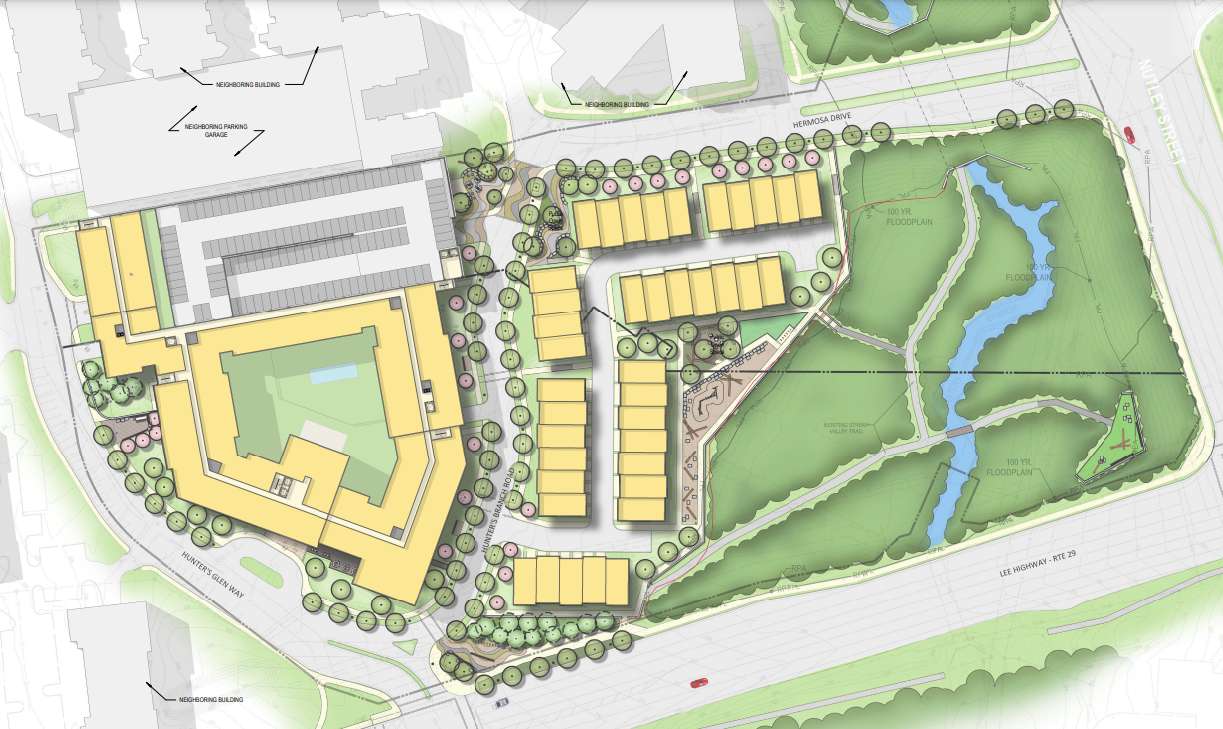
A second five-story garage would remain, but in a change from an initial concept that exclusively suggested residential uses, the developer proposes converting the eastern portion into up to 2,000 square feet of retail space — potentially “a small coffee shop or eatery.”
“This retail/restaurant space softens the exposed portion of the garage, activates the adjacent public plaza and uses some of the excess parking spaces in the garage for additional density,” the application says, noting that the immediate Vienna Metro station area is currently lacking in retail.
Approved plans for retail and commercial development elsewhere in the TSA have largely failed to materialize so far.
The plan also calls for around 76 townhomes as a “logical transition from the multifamily building to the large open space and environmental corridor on the eastern portion of the site.” While the units are described as “stacked” townhomes, they could be built as conventional side-by-side townhouses instead.
To reflect a theme of “enhancing human-scale connections with nature,” the developer has offered to reposition the Hunters Branch stream valley corridor as a natural park with reconstructed trails, a dog park, children’s playground, and other recreation areas.
Proposed road improvements to enhance pedestrian safety and connectivity include a redesigned Hunters Glen Way and Route 29 intersection with better crosswalks and a “Multi-modal Transportation Amenity Plaza” that could have bicycle racks, a bicycle repair station, electronic charging stations, seating, wayfinding signs for the Metro station and more.
Changes to the Route 29 and Nutley Street intersection are also being considered.
“Expanded pedestrian landing areas at the Nutley Street and Route 29 intersection will provide new pedestrian refuges and create a sense of arrival to the Vienna TSA,” Adams wrote. “Additional pedestrian and bicycle enhancements on the Property will further establish safe and accessible connectivity towards the Metro.”
The county hasn’t formally accepted the application for review yet.
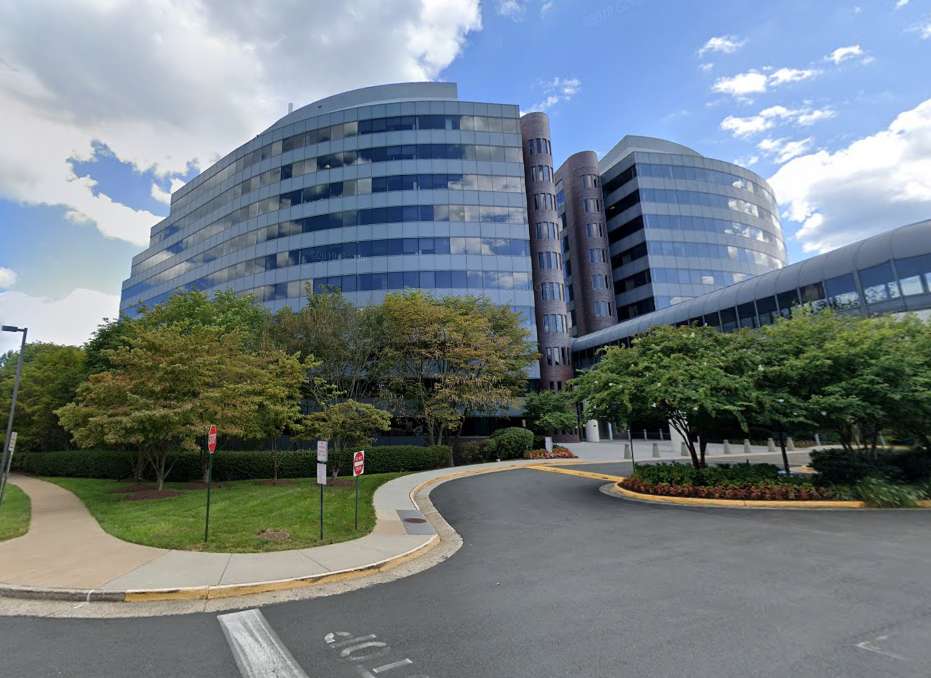
(Updated at 4:50 p.m.) After initially holding off, Fairfax County is now ready to consider allowing a redevelopment of the former ICF International headquarters in Oakton.
At Providence District Supervisor Dalia Palchik’s request, the Board of Supervisors authorized county staff on Nov. 21 to craft a comprehensive plan amendment that would open the door for residential or mixed-use development at the Hunters Branch office buildings (9300 and 9302 Route 29).
Constructed in 1987 and 1989, the 12-story, 200,000-square-foot buildings housed ICF for over three decades until the consulting firm relocated to Reston Station, a downsizing finalized in November 2022.
“Since ICF has moved out to Reston, this tower has been sitting there, and it’s surrounded by a very, I think, underappreciated area that needs environmental support,” Palchik said at last week’s board meeting. “…I know that the owners and developers are very committed to ensuring both the ecological support as well as the community amenity for this area.”
Property owners BCSP Hunters Branch Fee and BCSP Hunters Branch Lessee (BCSP) nominated the 13.9-acre site for potential land use changes last year as part of the county’s Site-Specific Plan Amendment process.
(Correction: This story initially suggested that the Hunters Branch owners are affiliates of the firm Beacon Capital Partners based on their corporate addresses. FFXnow has been told that they aren’t affiliates, and Beacon hasn’t had an ownership stake in the property since 2021.)
With the nomination, the property owners suggested two options for redeveloping Hunters Branch:
- “Adaptive reuse” of the office buildings as senior living facilities and/or multi-family dwelling units, and a replacement of an existing 706-space parking garage with multi-family housing
- An exclusively multi-family residential development
The proposal called for mid-rise buildings with five to seven stories and between 913 and 1,124 units. A second, 1,462-space parking garage would be retained in both scenarios.
However, the Board of Supervisors adopted the ICF nomination on April 11 in the third tier of its plan amendment work program, deferring a review to “allow for further development” of the scope, according to Palchik’s board matter.
With last week’s vote, the nomination was elevated to the work program’s highest-priority tier.
In a change from BCSP’s original proposal, the plan amendment could allow non-residential uses, such as ground-floor retail, as well as multi-family and townhouse buildings. Palchik said the site’s location within the Vienna Transit Station Area suggests “there may be advantages to consider a mix of uses.”
With demand for older office space declining post-pandemic, the property owners noted in their nomination that redeveloping the Hunters Branch offices would boost the county’s senior and multi-family housing stock. A “meaningful portion” of the new residences would be designated as affordable dwelling units.
“The area surrounding the Vienna/Fairfax-GMU Metrorail Station is emerging as a residential hub, and the community’s need for an increased and varied supply of housing in this location is growing,” Hunton Andrews Kurth counsel Jill Parks wrote as BCSP’s legal agent. “As such, it is critical that a mix of housing options be made available to the neighborhood’s current and prospective residents.”
When asked about the changes to the development proposal, Parks told FFXnow the developer doesn’t have any comment “at this time.”
Known as Land Bay A in the 56.9-acre Hunters Branch neighborhood, the former ICF office isn’t the only property in the Vienna Metro station area getting a new look. The board approved a plan on Sept. 12 to allow housing and additional retail at the nearby Pan Am Shopping Center, and discussions are underway for a redevelopment of AT&T’s Oakton campus.
Just south of the Metro station, the MetroWest development is also slated to get more residential buildings and a town center, though Fairfax County’s land use database indicates that site plans for both projects are still under review.
The faregates at the Vienna Metro station are sporting a new look.
Workers installed taller doors on the gates on Aug. 9 as part of a systemwide retrofit project intended to combat fare evasion, which costs Metro an estimated $40 million per year in lost revenue, according to the transit agency.
“The bottom line is fare evasion is not okay, and we will continue our efforts to ensure everyone is respecting the community’s system and each other,” Metropolitan Washington Area Transit Authority CEO and General Manager Randy Clarke said in a news release announcing the rollout of the project last month.
The Vienna station is the only one in Fairfax County to be featured in the project’s first phase, which also includes stations in Arlington, D.C. and Maryland.
The first phase is expected to be completed by early fall. A Metro spokesperson says there are no updates yet beyond that initial timeline, but all 103 rail stations are slated to get the retrofit over the next year.
At 55 inches tall, the new doors are stronger and more resilient than the original faregates, which were updated just last year, WMATA said.
The new design includes an L-shape door panel that extends over the faregate to minimize gaps between the openings. The increase in barrier height from the original 28 to 48-inch prototype to 55 inches will also make it more difficult to jump over faregates. The new height is taller than a hockey net or nearly half the height of a standard basketball hoop.
The swing doors are made of a polycarbonate which is 200 times stronger than glass, lighter weight, and more durable. The final design also includes more robust hinges and a more powerful motor to strengthen the door. As stations are retrofitted with the new barriers, Metro is also raising the height of fencing and emergency gates.
Metro will install a single door panel for all regular faregates, and double door panels at the wider gates for accessibility and wheelchairs.
Prior to the rollout of the new doors, Metro launched a reduced fare program that lets SNAP recipients who live in Virginia, Maryland and D.C. ride its trains and buses at a 50% discount.
“To-date, more than 1600 customers have enrolled, taking nearly 17,000 combined trips,” WMATA said on July 24.
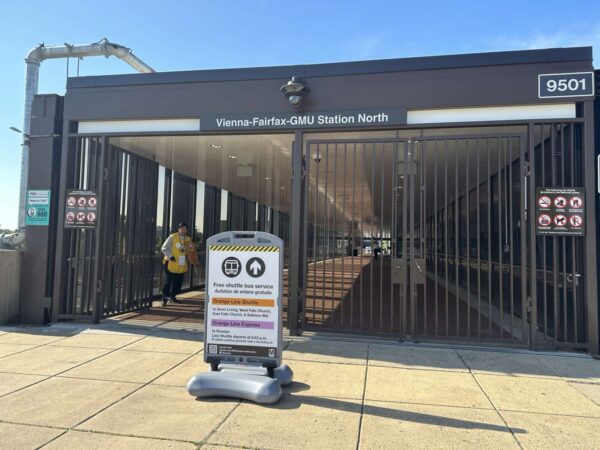
Train service will be back at the Vienna and Dunn Loring Metro stations, starting Monday (July 17).
The two stations at the western end of the Orange Line have out of commission since June 3 so Metro crews could replace a 40-year-old rail and install fiber-optics cables. The project also affected the West and East Falls Church stations, which reopened on June 26.
“Replacing this section of rail was critical to ensuring the Orange Line is safe and reliable for years to come,” Metro Chief of Infrastructure Andy Off said, announcing the project’s completion. “We appreciate our customers’ patience while we completed this important work to improve our system.”
The rail between the Vienna and Ballston stations was some of the oldest in the Metro system and needed to be replaced “to improve safety and reliability,” according to the Washington Metropolitan Area Transit Authority.
During the second phase of the project, workers replaced nearly 25 miles of rail and removed over 97,000 linear feet of vegetation around the Vienna and Dunn Loring stations. Another 15.5 miles of rail and 42,000 linear feet of vegetation was addressed during the first phase focused on the Falls Church stations.
“Overgrown plants and brush…could cause an obstruction during a storm,” Metro said in its press release.
After the Orange Line stations reopen, the transit agency will shift its construction efforts east to the Green Line between Fort Totten in D.C. and Greenbelt, Maryland:
Summer construction will now move to the Green Line beginning July 22, when Metro will install fiber-optic cable, replace platform edge lighting, and replace power cables and switch machines. Upgrading the switch machines and installation of the new cables will ensure reliable service for years to come.
Green Line stations between Fort Totten and Greenbelt will be closed from Saturday, July 22, to Monday, September 4. Green Line service at Fort Totten will be unavailable July 22 and July 23. Red Line service will remain available at Ft. Totten. Frequent free shuttle buses will replace trains between the affected stations. Customers are advised to allow extra time for their travel. In addition to prominent signage and announcements in the stations and on trains, additional Metro staff will be available to assist customers at the affected stations.
Metro’s train service runs from 5 a.m. to midnight on Monday through Thursday, 5 a.m. to 1 a.m. on Friday, 7 a.m. to 1 a.m. on Saturday, and 7 a.m. to midnight on Sunday.
This weekend, free local shuttles between the Vienna, Dunn Loring and West Falls Church stations will continue to be available during those hours, along with express service between Vienna and West Falls Church.
Dunn Loring riders won’t be entirely free of construction next week. Work to replace two escalators at the station has been underway since mid-March and is expected to continue until the end of October.
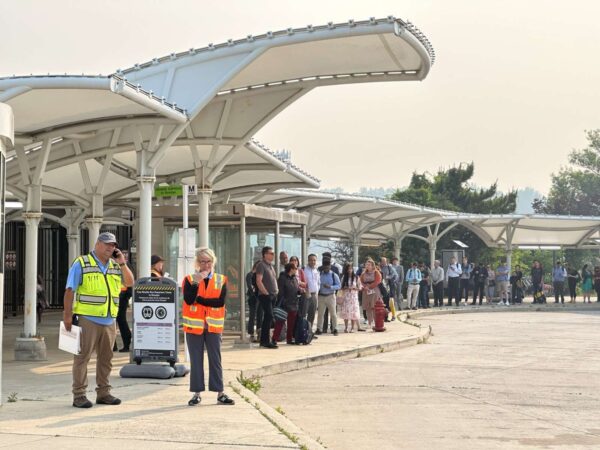
Some good news is on the horizon for local Metrorail riders: the West and East Falls Church stations are set to reopen on Monday (June 26) after a 23-day closure.
The bad news? The Vienna and Dunn Loring stations will remain closed through July 16.
Orange and Silver line service at the four stations ceased on June 3 so Metro crews could replace a 40-year-old steel rail. The transit agency is also using the closures to install fiber optic cables and clear vegetation along or near the train tracks.
After laying down nearly 1,800 tons of rail and removing “more than 42,000 linear feet of trees, bushes, grasses, and invasive vines,” the Washington Metropolitan Area Transit Authority says it will advance to the project’s second phase next week.
“Our team has made great progress on this work so far. As of last week, our team has replaced 15.5 miles of track, installed nearly 36 miles of fiber-optic cable, replaced two diamond interlockings, and installed 13 new switch machines,” Metro Chief of Infrastructure Andy Off said. “They are working to keep the system safe and reliable, and we thank our customers and visitors to the area for their understanding and patience.”
The extended shutdown has been a source of frustration for many commuters in Northern Virginia, despite Metro’s efforts to minimize disruptions by providing free shuttles.
After getting reports of long lines and wait times for the shuttles, particularly at the Vienna and Ballston stations, WMATA said on June 7 that it would add more buses, coordinate with police to ensure free movement through traffic and reevaluate routes through the more congested areas of Rosslyn.
However, the transit agency noted that wait times could still reach 20 minutes during peak rush hours “based on the volume of customers at these stations.”
Some waiting should still be expected at the Vienna, Dunn Loring and West Falls Church stations going forward, Metro says, advising riders “to allow extra time for their travel,” especially during rush hour.
From June 26 through July 16, free shuttles will be provided with stops at those three stations, arriving every 10 to 20 minutes. There will also be an Orange Line Express with service between Vienna and West Falls Church every eight to 15 minutes on weekdays.
Standard buses from Metro and other transit services, including Fairfax Connector, will be available as well: Read More
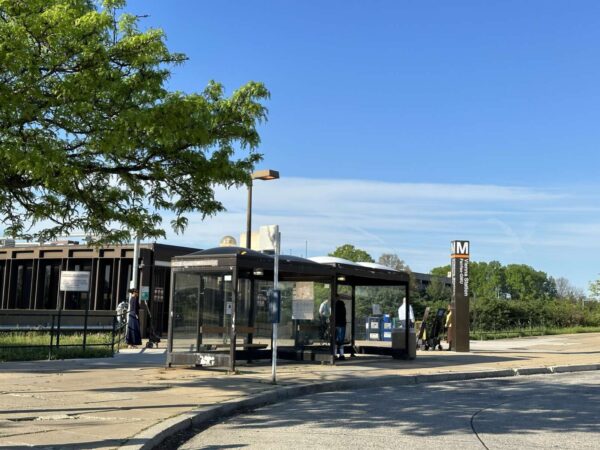
Metro will assemble an armada of shuttles this summer to support travelers during its multi-week shutdowns of several stations on the Orange, Silver and Green lines.
The Washington Metropolitan Area Transit Authority (WMATA) announced yesterday that free shuttle buses will be available throughout the closures, which will begin on May 12 and roll out to Fairfax County’s Orange Line stations starting June 3.
During the closures, the agency will conduct maintenance work at each of the stations and modernize their facilities.
“Continued maintenance work is essential to safe and reliable rail service,” WMATA Chief of Infrastructure Andy Off said in the press release. “We are working strategically to target maintenance locations and minimize the impacts on customers as we conduct this critical work to upgrade systems, improve reliability, and modernize station facilities.”
In Fairfax County, the closures will take place in two phases.
First, the Vienna, Dunn Loring, West Falls Church and East Falls Church stations will close from June 3 to 25 so that Metro can replace the 40-year-old train rails and add fiber-optic cables.
“Replacing the track in this section is a top priority to ensure safety and increase reliability,” WMATA said.
A combination of local, express and limited-stop shuttle service will be offered:
Orange Line Shuttle: Local service between Vienna, Dunn Loring, West Falls Church, East Falls Church, and Ballston-MU stations.
- Local service between McLean, East Falls Church, and Ballston-MU stations.
- Every 5 minutes during rush hours. (6- 9 a.m., 3-7 p.m.)
Orange Line Express: Express service between Vienna and Rosslyn stations.
- Service every 5 minutes during rush hours. (6-9 a.m., 3-7 p.m.)
- Service every 10 minutes during non-rush hours. (9 a.m.-3 p.m., 7-9 p.m.)
Silver Line Limited: Limited-stop service between Washington Dulles International Airport, McLean, and Rosslyn.
- Service every 5 minutes during rush hours. (6-9 a.m., 3-7 p.m.)
- Service every 10 minutes during non-rush hours. (9 a.m.-3 p.m., 7-9 p.m.)
Silver Line riders will need to take a shuttle to bypass the East Falls Church transfer station. Trains between Ashburn and McLean will run every eight minutes, except after 9:30 p.m., when they will operate every 10 minutes.
Both of the Falls Church stations will reopen on June 26, but the Vienna and Dunn Loring stations will stay closed through July 16 to finish the rail replacement and cable installation.
Free local shuttle service will be provided betwen the Vienna, Dunn Loring and West Falls Church stations, operating every 5 to 10 minutes on weekdays and every 10 minutes on weekends while Metrorail is open.
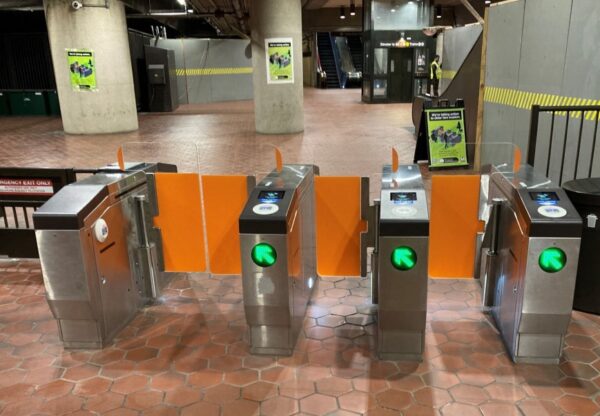
Saloon-style doors are coming to the Vienna Metro station’s fare gates.
The Orange Line terminus is one of nine stations in the first phase of Metro’s fare gate retrofits, which will install taller, glass doors on all of the transit agency’s recently modernized gates to deter people from jumping over to avoid paying to ride the rails.
The first phase will focus on stations with only one entrance and, therefore, fewer gates, Washington Metropolitan Area Transit Authority officials told the Board of Directors on Thursday (March 23).
Other stations in the first phase include Court House and Pentagon City in Arlington; Federal Center Southwest, Congress Heights, Mount Vernon Square and Fort Totten in D.C.; and Bethesda, Wheaton and Addison Road in Maryland.
“We have done some work to determine that the infrastructure needs to do the retrofits are minimal, a way for the team to learn and progress as they’re installing these retrofits,” WMATA Chief Planning and Performance Officer Tom Webster said.
Metro began testing doors aimed at preventing fare evasion last November at the Fort Totten station, including a design with “anti-vaulting arches” that proved ineffective.
The pilot launched before the agency had even finished outfitting all stations with their first updated fare gates since the 1990s, a process that lasted from 2021 to this past December. Though Metro estimated in 2019 that fare evasion was costing it $10 million, board members didn’t want gates that evoked cages like the ones in New York City, according to DCist.
However, reducing fare evasion has emerged as a top priority for WMATA General Manager and CEO Randy Clarke since he took over the job in July.
The new gates have sensors that register all users, regardless of whether they tap their SmarTrip card to pay, giving WMATA more accurate data on rail ridership, Webster said.
So far this year, Metro has seen about 22.3 million rail users, averaging 324,000 trips on weekdays, and the roughly 404,000 trips recorded on Wednesday (March 22) represent the system’s highest single-day ridership of the pandemic, Webster reported at the board meeting.
Metro’s new data indicates that approximately 13% of those total riders didn’t pay at the fare gate. While acknowledging that riders may not be paying for a variety of reasons, including college and D.C. students who can ride for free, the agency says fare evasion affects both its finances and its optics. Read More
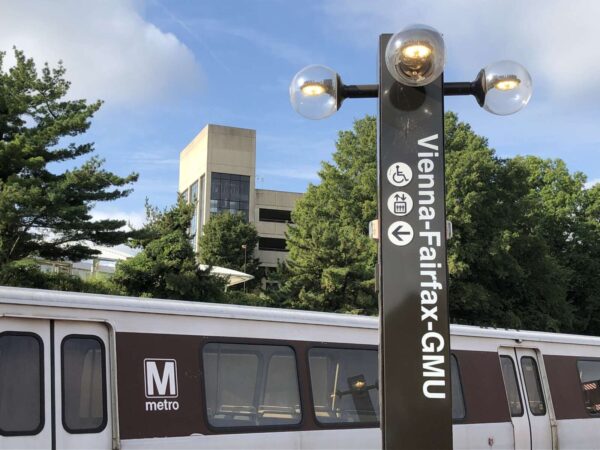
(Updated at 3:50 p.m. on 1/31/2023) Just three years after going a full season without Metro, Fairfax County’s Orange Line stations will again be subjected to an extended summer shutdown, as the transit agency works to upgrade some of its equipment.
As part of a larger maintenance work plan, the Vienna and Dunn Loring stations will be closed from June 3 to July 27 so Metro can replace a steel rail that has degraded, the Washington Metropolitan Area Transit Agency announced yesterday (Tuesday).
The replacement will unfold in two phases “to reduce the customer impact,” according to Metro. During the first phase from June 3-26, the closure will also include the West and East Falls Church stations. Those stations will reopen on June 27.
(Correction: This article previously reported that the Ballston and McLean stations will also be closed during the first phase. Metro has clarified that they will remain open, but a shuttle will be needed to get around the East Falls Church station closure.)
“The Infrastructure team will focus on replacing 40-year-old steel rail that has become significantly more susceptible to rail breaks than rail in any other part of the system,” WMATA said. “Metro has been tracking rail breaks in the system to identify priority locations for replacement and has determined the rail in this stretch of track to be a top priority.”
The work will also include a replacement of the copper cables at the stations with fiber-optic cables, giving them “advanced radio, signal, and train communication technology.”
Metro typically schedules its major maintenance projects during the summer when there’s lower ridership, according to the news release.
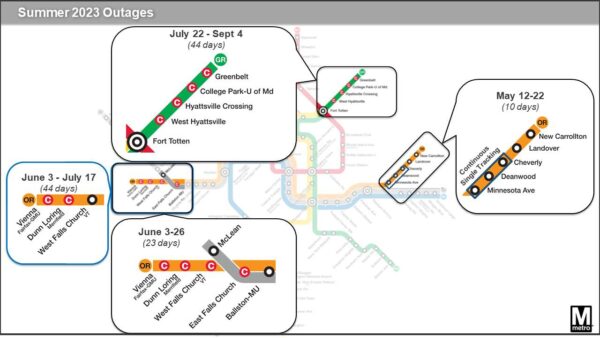
This year’s plan is focused on modernizing the rail system. It will also involve single-tracking on the Maryland end of the Orange Line from May 12 to 22 and a 44-day shutdown of the Maryland end of the Green Line from July 22 to Sept. 4.
“Continued maintenance work is essential to safe and reliable rail service,” WMATA Executive Vice President of Infrastructure Andy Off said in a statement. “We are working strategically to target maintenance locations and minimize the impacts on customers as we conduct this critical work to upgrade systems, improve reliability, and modernize station facilities.”
A Metro spokesperson said the agency is “working on a shuttle bus plan to connect the closed stations and will announce the travel alternatives well ahead of the stations closures.”
This summer’s partial Orange Line shutdown won’t be as extensive as the three-month-long closure of 2020, when Metro overhauled the station platforms.
When ridership plummeted that spring due to the COVID-19 pandemic, the agency expanded the closure to include the Silver Line between Ballston and Wiehle-Reston East so that it could connect those stations to the upcoming extension into Loudoun County.
The Silver Line stations ultimately reopened that August, followed by the Orange Line stations just after Labor Day. Even with the unexpected leeway for construction in 2020, the Silver Line extension still encountered several delays before finally launching service last November.
According to its online rail data, the Vienna Metro station is averaging the most daily rail entries out of the four Fairfax County stations that will be affected this summer, as of November:
- Vienna — 8,794 entries
- West Falls Church — 4,674 entries
- Dunn Loring — 3,543 entries
- McLean — 928 entries
In a quarterly report last fall, WMATA reported its highest ridership levels since the pandemic took hold in March 2020, though the 45.6 million riders across rail and bus was still just 60% of 2019 levels.
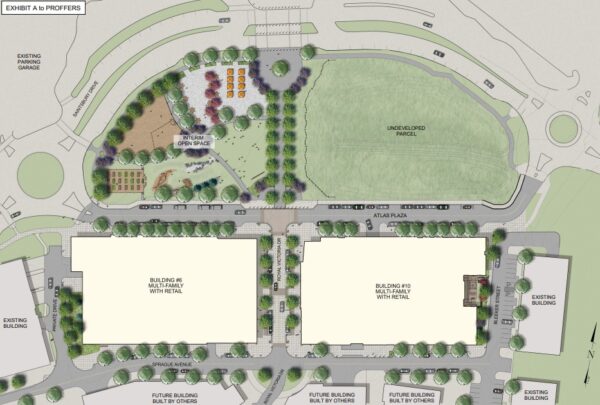
A path has been cleared for construction to begin soon on the long-awaited MetroWest town center, promising retail and pedestrian safety enhancements near the Vienna Metro station in Oakton.
As recommended by the planning commission in late October, the Fairfax County Board of Supervisors voted last week to remove a limit on the number of residences allowed at the mixed-use development before work also starts on planned office buildings.
Occupying approximately 9.8 acres directly south of the Metro station, the future town center will bring up to 900 residential units, 300,000 square feet of office, and at least 55,000 square feet of retail to the 56-acre MetroWest development.
Developer CRC Companies said at the public hearing on Nov. 1 that the county is on the verge of approving site plans for the first two residential buildings, which will combine for more than 500 units and 12,000 to 15,000 square feet of retail space.
“To say that’s a long time coming is probably the biggest understatement of the afternoon, if you know the history and legacy of MetroWest at all,” McGuireWoods attorney Greg Riegle said, representing CRC at the hearing.
When originally approved in 2006, MetroWest was capped at 1,100 residential use permits (RUPs) until some construction is completed on one of the planned office buildings, but market changes have stalled the commercial portion of the project.
With 706 dwellings already built and 408 more units on the way from fellow developer Pulte Homes, CRC sought to have the condition removed so it can also deliver the town center’s third and final residential building — and the accompanying retail and open space that has failed to materialize.
“By continuing to develop the town center and round out the amenity package, that’s the best chance to make the office actually happen at MetroWest,” Riegle said.
As part of the updated development conditions, known as proffers, CRC will provide a 2-acre interim open space with an asphalt trail on Atlas Plaza “to create a walkway circuit,” according to a county staff report. The plaza will eventually be replaced by the third residential building.
The town center will have a permanent plaza between that residential building and the two office buildings, but CRC isn’t required to build it until the first RUP or occupancy permit is issued for the second of those buildings to be constructed.
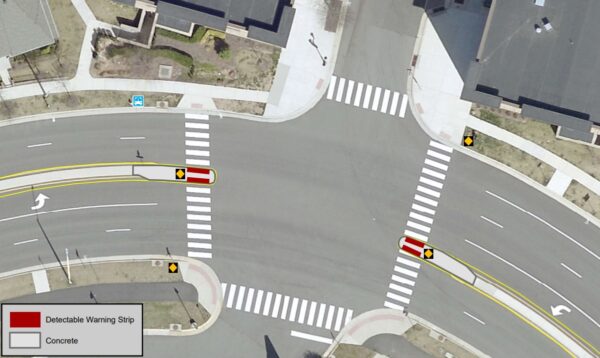
The developer has also agreed to construct pedestrian safety improvements along Vaden Drive and at its intersection with Royal Victoria Drive, right in front of the Providence Community Center.
The proposed improvements will extend the existing concrete medians on Vaden Drive into the crosswalks, adding detectable warning strips and rapid flashing beacons, shown as yellow diamonds on the diagram above.
“There’s quite a bit of pedestrian, bike, family, dog activity, and improvement to that safety is definitely a priority for the community members, for the residents, and for my office,” Providence District Supervisor Dalia Palchik said.
Though it’s unclear when construction on the town center will begin (CRC didn’t return an inquiry from FFXnow by press time), Palchik and other supervisors expressed hope that their vote will allow the county’s vision for a vibrant, mixed-use community at the Vienna Metro to finally come to fruition.
Hunter Mill District Supervisor Walter Alcorn and Franconia Supervisor Rodney Lusk recalled discussing the MetroWest plan when they served on the planning commission back in 2006. The meeting lasted until 3:45 a.m., according to Alcorn.
“I appreciate where it’s come and see this as a very vital and necessary step for this development,” Lusk said.
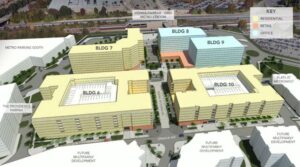
The Fairfax County Planning Commission will soon decide whether to remove a condition that could allow construction to start on the planned town center at MetroWest.
The proposed buildings would bring up to 900 residential units and retail amenities to the 56-acre community south of I-66 and the Vienna Metro Station.
According to an application submitted in January, developer CRC Companies asked the commission to remove a condition, also known as a proffer, that limits how much a housing developer can build without providing the 300,000 square feet of office space.
The original MetroWest plans were approved in 2006, and the proffer was put in place to guarantee different uses for the space. However, CRC has argued that the real estate market has changed since it was approved, making office space less viable.
The developer also said the proffer hinders the development of retail and open space for existing residents.
During the planning commission’s public hearing on the amendment last week (Oct. 20), McGuireWoods managing partner Gregory Riegle announced that construction on the first phase of the town center would begin soon.
“We are literally within weeks or months of starting to construct the first phase under the governing proffers and understanding that this has always been an important project,” Riegle said. He also briefly explained why developers are requesting a change to the existing proffer.
“The reasons for this change are perhaps self-evident, given well-documented realities about an objective oversupply of office space combined with decreasing demand,” he said.
Riegle noted that the amenities, size and scale, retail, and the required urban design would not change if the proffer were revised.
The Fairfax County Planning Commission deferred the final decision to its meeting tomorrow.

